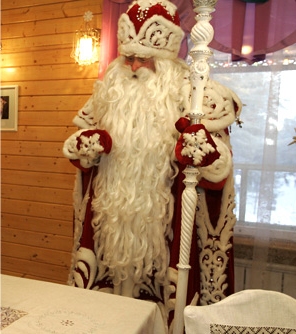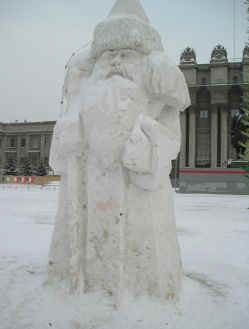In
the culture of the Slavs the traditional character Ded Moroz (Russian:
Дед Мороз) plays a role
similar to that of Santa Claus. The literal translation of the name would be
Grandfather Frost. However, English-speakers traditionally translate his
name as the alliterative Father Frost.
Ded
Moroz brings presents to children. However, unlike the secretive ways of
Santa Claus, he often brings them in person, at the celebrations of the New
Year, at New Year parties for kids by the New Year Tree. The “in-person”
gifts only occur at big organized celebrations, where the gifts can be
“standardized.” The clandestine operations of placing the gifts under
the New Year tree still occur while the children are young. Ded Moroz is
accompanied by Snegurochka (Russian:
Снегурочка), or
‘Snow Maiden’, his granddaughter. She is a unique attribute of the image
of Father Frost – none of his foreign colleagues has a similar companion.
The
traditional appearance of Ded Moroz has a close resemblance to that of Santa
Claus, with his coat, boots and long white beard. Specifically, Ded Moroz
wears a heel-long fur coat, a semi-round fur hat, and white valenki or high
boots (sapogi), silver or red with silver ornament. Unlike Santa Claus, he
walks with a long magical staff, does not say “Ho, ho, ho,” and drives
no reindeer but a troika.

Ded Moroz at
his residence in Veliky Ustyug
The
official residence of Ded Moroz in Russia is the town of Veliky Ustyug. The
residence of the Belarusian Dzied Maroz is in Belavezhskaya Pushcha.
Strange
as it is, initially Father Frost used to be a wicked and cruel sorcerer who
liked to freeze people. He took after the Old Slavic gods: ‘Pozvizd’ -
the god of wind and good and bad weather, ‘Zimnik’ - god of winter, and
the terrifying ‘Korochun’ – an underworld god ruling over frosts. The
peculiar character of those pagan gods determined the initial disposition of
Ded Moroz – at first he stole children and brought them away in his
gigantic sack. To ransom the kids, their parents had to give him presents.
However, with the lapse of time, everything turned upside down: under the
influence of Orthodox traditions Father Frost reformed, became kind and
started to give presents to kids. Then he adopted certain traits from Saint
Nicholas, the prototype of the Western Santa Claus.
His
roots are in pagan beliefs, but since the 19th century his attributes and
legend have been shaped by literary influences. He, together with
Snegurochka, was “fleshed out” from a kind of a winter sprite into what
he is now. The fairy tale play Snegurochka by the famous Russian playwright
Aleksandr Ostrovsky was influential in this respect, followed by
Rimsky-Korsakov’s Snegurochka with libretto based on the play.
Only
by the end of the 19th century did Ded Moroz win a “competition” between
the various mythical figures who were in charge of New Year presents:
including Grandfather Nicholas, Santa Claus, Ded Treskun, Morozko and simply
Moroz. Ded Moroz perfectly fits the Russian traditions, so there is a
widespread erroneous opinion that he has been known to Russians for
centuries.
